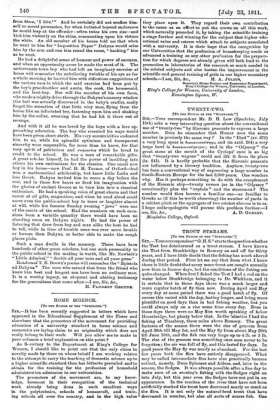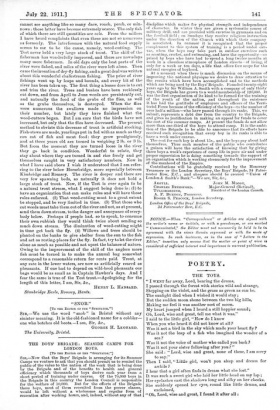TROUT STREAMS.
[To THE EDITOR. Or THE "SFECTI,TOE."3 SID,—Yourcorrespondent" 0.11. S." starts the question whether the Test has deteriorated as a trout stream. I have known the Test from Stockbridge to Romsey on and off for thirty years, and I have little doubt that the fishing has much altered during that period. First let me say that from what I know there is little doubt that many more trout are caught annually now than in former days, but the conditions of the fishing are quite changed. When first I fished the Test I had a rod on the water below Stockbridge belonging to Dr. Wickham, and it is certain that in those days there was a much larger and more regular hatch of fly than now. During April and May every day at some period there was a good hatch of fly. Of course this varied with the day, lasting longer, and being more plentiful on good days than in bad fishing weather, but you could always rely on a rise some time every day. Even in those days there were no May flies worth speaking of below Horse bridge, but plenty below that. In the 'nineties I had the fishing at Timsbury, three miles above Romsey. The great features of the season there were the rise of granom from April 20th till May 1st, and the May fly from about May 20th till June 10th, and the fish ran very large up to 4 lb. or 5 lb. The rise of the granom was something once seen never to be forgotten ; the air was full of fly, and this lasted for days. In good years the May fly was nearly as abundant. For the last few years both the flies have entirely disappeared. What may be called intermediate flies have also practically become extinct, namely, Duns Spinners and Alders, and, later in the season, the Sedges. It was always possible after a fine day to make sure of an evening's fishing with the Sedges right on into July, but this year even the Sedges have not put in an appearance. In the reaches of the river that have not been artificially stocked the trout have decreased nearly as much as the flies. It is not only the natairai-bred trout that have decreased in number, but also all sorts of =tree fish. One cannot see anything like so many dace, roach, perch, or min- nows: these latter have become extremely scarce. The only fish of which there are still quantities are eels. From the millers I have heard complaints that even these are not so numerous as formerly. The interference with the natural food supply seems to me to be the cause, namely, weed-cutting. The Test never held a very large stock of trout. The skill of the fisherman has wonderfully improved, and there are nowadays many more fishermen. In old days only the best parts of the river were fished, and miles of the river were left alone. Then came the invention of dry-fly fishing, and a great deal was written about this wonderful chalkstream fishing. The price of river fishings went up by leaps and bounds, and every bit of the river has been taken up. The first thing a lessee does is to cut and trim the river. Trees and bushes have been recklessly cut down, and from April to June weeds are persistently cut, and naturally the food of the grubs of the flies, as well as the grubs themselves, is destroyed. When the flies were numerous the swallows made no impression on their number, but lately they have finished what the weed-cutters began. But I am sure that the birds have not increased, but only that the flies have decreased. The present method to obviate this decrease of trout is artificial stocking. Fish-stews are made, yearlings put in fed with as much as they can eat of fish and meat food : they grow prodigiously, and at three years old are turned in weighing 2 lb. or 3 lb. But frons the moment they are turned loose in the river they go back in condition. Wonderful to relate, they stay about where they are turned in and rise freely and get themselves caught in very satisfactory numbers. Now in what I have said above I wish it understood that I am refer- ring to the river below Horsebridge, more especially between Kimbridge and Romsey. The river is deeper and there are very few spawning beds, so naturally it does not hold a large stock of trout. Now, if the Test is ever again to be a natural trout stream, what I suggest being done is : (1) to have an organization that can make rules and will have those rules enforced. (2) That weed-cutting must to a great extent be stopped, and be very limited in time. (3) That those who cut weeds must take them out of the river and not, as at present, send them down stream, to the danger and annoyance of every- body below. Perhaps if people had, so to speak, to consume their own rubbish they would think twice about sending so much down stream. The diminution of weed-cutting might in time get back the fly. (4) Willows and trees should be planted on the banks to give shelter from the sun to the fish and act as resting-places for the fly. In fact, try to let the river alone as much as possible and not upset the balance of nature. Owing to the improvement of the skill of the anglers more fish must be turned in to make the annual bag somewhat correspond to a reasonable return for rents paid. Trout, at any rate in the lower waters, are now as artificially reared as pheasants. If one had to depend on wild-bred pheasants our bags would be as small as in Captain Hawker's days. And I fear the same is true of the Test trout.—Apologizing for the length of this letter, I am, Sir, &c.,







































 Previous page
Previous page